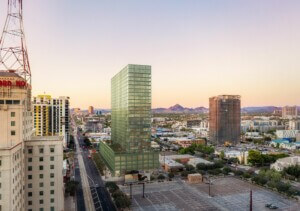Arizona-based practice Studio Ma has unveiled renders for a new U.S. Embassy building in Praia, the capital city of Cape Verde or Cabo Verde, a small archipelago nation off the coast of West Africa. The firm, which maintains a strong environmental emphasis in their design work, has created a building that will respond to Praia’s unique climate, characterized by dry desert heat for most of the year punctuated by bouts of extreme annual flooding during the late summer.

When designing the new facility, Studio Ma conducted interviews with the embassy’s staff, who suggested the addition of drought-prone plantings to create shade and increased communal areas.
Communal space will be provided through a central courtyard or kintal, which means outdoor room in Kriolu, a Portuguese-Creole dialect commonly spoken in Cape Verde. The kintal often serves as a venue for the performance of the nation’s rich and varied musical styles, which include morna, funaná, batuku, and more.

Studio Ma also worked with a local musicologist who taught the architects about the batuku beat and its relationship to the islands’ history of slavery and eventual independence movement. According to a press release from the firm, the beat’s syncopated rhythm has been incorporated into the design of the new building’s facade.
The facade will be clad in Jura limestone and locally sourced basalt. Basalt is common across the archipelago given its volcanic geology. Stone was chosen for its performance, namely, resistance to heat and salt-spray corrosion.
To prepare for Praia’s brief wet season, the site will be equipped with a system of bioswales and rain gardens.
Renderings of the interiors show a continuation of the limestone. The linear, rhythmic texture applied on the facade also seeps indoors, as seen in the ceiling.

In addition, the building has been designed to produce 80 percent of its estimated energy usage through solar panels as well as batteries for energy storage. Importantly, this will allow the embassy to mostly bypass Praia’s carbon-intensive energy production systems.











